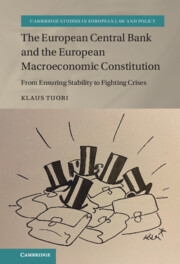 The European Central Bank and the European Macroeconomic Constitution
The European Central Bank and the European Macroeconomic Constitution from Part II - Crises, ECB Measures and the Macroeconomic Constitution
Published online by Cambridge University Press: 15 September 2022
The ECB started its QE called the PSPP in 2015 as a new monetary policy measure. By purchasing vast monthly amounts of main Member State government bonds, the ECB aimed to force investors towards riskier assets, which in turn, was to increase asset prices and support bank lending, and ultimately lead to growth and inflation. Constitutionally, QE was a new type of complication for the European Macroeconomic Constitution. The ECB became the largest creditor of Member States it was prohibited to finance. The constitutional assessment of the PSPP combines the analysis of the CJEU’s Weiss case that contains very limited constraints for the ECB, and more economic-constitutional and thus substantive analysis. One key question is whether the PSPP is monetary policy, which can be analysed through its objectives, its economic content and examples of other central banks that mostly support an affirmative conclusion. The euro area constitutional structure adds further complications that were also raised in the FCC’s Weiss judgment. The PSPP has arguably broader implications for other areas of economic policy, as it facilitates Member States public finances and increases wealth differences by increasing asset prices, as well as making the ECB deeply dependent on Member States public finances.
To save this book to your Kindle, first ensure [email protected] is added to your Approved Personal Document E-mail List under your Personal Document Settings on the Manage Your Content and Devices page of your Amazon account. Then enter the ‘name’ part of your Kindle email address below. Find out more about saving to your Kindle.
Note you can select to save to either the @free.kindle.com or @kindle.com variations. ‘@free.kindle.com’ emails are free but can only be saved to your device when it is connected to wi-fi. ‘@kindle.com’ emails can be delivered even when you are not connected to wi-fi, but note that service fees apply.
Find out more about the Kindle Personal Document Service.
To save content items to your account, please confirm that you agree to abide by our usage policies. If this is the first time you use this feature, you will be asked to authorise Cambridge Core to connect with your account. Find out more about saving content to Dropbox.
To save content items to your account, please confirm that you agree to abide by our usage policies. If this is the first time you use this feature, you will be asked to authorise Cambridge Core to connect with your account. Find out more about saving content to Google Drive.